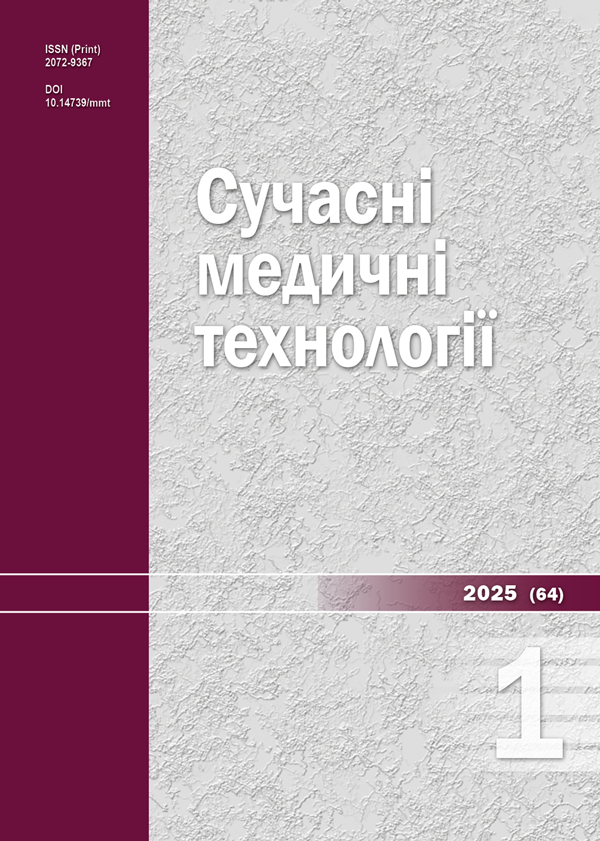Clinical, pathogenetic and prognostic significance of vascular endothelial growth factor content in the blood serum of patients with coronavirus disease (COVID-19) with pneumonia in relation to the parameters of immune inflammation and haemostasis in assessing the risk of death
DOI:
https://doi.org/10.14739/mmt.2025.1.320833Keywords:
coronavirus disease, COVID-19, viral infection, pneumonia, endothelial dysfunction, thrombotic complications, diagnosis, prognosisAbstract
Aim. To find out the clinical, pathogenetic and prognostic significance of vascular endothelial growth factor in the blood serum of patients with coronavirus disease with pneumonia in relation to the parameters of immune inflammation and haemostasis in assessing the risk of death.
Material and methods. We examined 123 patients with coronavirus disease (COVID-19) with pneumonia. Laboratory examination of patients was carried out in accordance with the Order of the Ministry of Health of Ukraine of 28.03.2020 No. 722. The patients were divided into groups depending on the outcome of the disease: 77 patients who recovered and 46 patients who died. The content of vascular endothelial growth factor (VEGF) (total form) in the blood serum was determined by enzyme-linked immunosorbent assay (Immuno-Biological Laboratories Co., Ltd., Japan). Statistical data processing was performed in the program “Statistica for Windows 13”.
Results. It was found that in patients with coronavirus disease with pneumonia, the level of increase in serum VEGF (total form) was associated with the outcome of the disease. When patients were hospitalised on day 9.0 [7.0; 12.0] of illness, a serum VEGF level >32.04 pg/ml (AUC = 0.842, p < 0.001) indicated a high risk of adverse outcome, and after 7 days of treatment, with a VEGF level >58.79 pg/ml (AUC = 0.899, p < 0.001), there was a high probability of death. The correlation between the development of thrombotic complications and the level of VEGF increase in the blood serum both at the time of hospitalisation (gamma +0.32, p < 0.05) and after 7 days of treatment (gamma +0.37, p < 0.05) was established. The occurrence of thrombotic complications was more frequent in patients with a fatal outcome than in patients who had recovered (18.4 times, p = 0.000001). The level of VEGF in the blood serum >51.91 pg/ml (AUC = 0.680, p = 0.019) was prognostic of the risk of developing thrombotic complications only in the dynamics after 7 days of hospital treatment. The clinicopathogenetic role of increased serum VEGF in the progression of the disease in patients with COVID-19 pneumonia was demonstrated by statistically significant correlations.
Conclusions. In patients with COVID-19 pneumonia, VEGF (total form) level elevation in serum is associated with the risk of death. The threshold levels of VEGF, which are informative for prognosing the risk of unfavourable disease course at different follow-up periods, have been established.
References
Smadja DM, Mentzer SJ, Fontenay M, Laffan MA, Ackermann M, Helms J, et al. COVID-19 is a systemic vascular hemopathy: insight for mechanistic and clinical aspects. Angiogenesis. 2021;24(4):755-88. doi: https://doi.org/10.1007/s10456-021-09805-6
Hariri LP, North CM, Shih AR, Israel RA, Maley JH, Villalba JA, et al. Lung Histopathology in Coronavirus Disease 2019 as Compared With Severe Acute Respiratory Sydrome and H1N1 Influenza: A Systematic Review. Chest. 2021;159(1):73-84. doi: https://doi.org/110.1016/j.chest.2020.09.259
Nicolai L, Leunig A, Brambs S, Kaiser R, Joppich M, Hoffknecht ML, et al. Vascular neutrophilic inflammation and immunothrombosis distinguish severe COVID-19 from influenza pneumonia. J Thromb Haemost. 2021;19(2):574-81. doi: https://doi.org/10.1111/jth.15179
Middleton EA, He XY, Denorme F, Campbell RA, Ng D, Salvatore SP, et al. Neutrophil extracellular traps contribute to immunothrombosis in COVID-19 acute respiratory distress syndrome. Blood. 2020;136(10):1169-79. doi: https://doi.org/10.1182/blood.2020007008
Goshua G, Pine AB, Meizlish ML, Chang CH, Zhang H, Bahel P, et al. Endotheliopathy in COVID-19-associated coagulopathy: evidence from a single-centre, cross-sectional study. Lancet Haematol. 2020;7(8):e575-e582. doi: https://doi.org/10.1016/S2352-3026(20)30216-7
Helms J, Tacquard C, Severac F, Leonard-Lorant I, Ohana M, Delabranche X, et al. High risk of thrombosis in patients with severe SARS-CoV-2 infection: a multicenter prospective cohort study. Intensive Care Med. 2020;46(6):1089-98. doi: https://doi.org/10.1007/s00134-020-06062-x
Rovas A, Osiaevi I, Buscher K, Sackarnd J, Tepasse PR, Fobker M, et al. Microvascular dysfunction in COVID-19: the MYSTIC study. Angiogenesis. 2021;24(1):145-57. doi: https://doi.org/10.1007/s10456-020-09753-7
Pine AB, Meizlish ML, Goshua G, Chang CH, Zhang H, Bishai J, et al. Circulating markers of angiogenesis and endotheliopathy in COVID-19. Pulm Circ. 2020;10(4):2045894020966547. doi: https://doi.org/10.1177/2045894020966547
Smadja DM, Philippe A, Bory O, Gendron N, Beauvais A, Gruest M, et al. Placental growth factor level in plasma predicts COVID-19 severity and in-hospital mortality. J Thromb Haemost. 2021;19(7):1823-30. doi: https://doi.org/10.1111/jth.15339
Kong Y, Han J, Wu X, Zeng H, Liu J, Zhang H. VEGF-D: a novel biomarker for detection of COVID-19 progression. Crit Care. 2020;24(1):373. doi: https://doi.org/10.1186/s13054-020-03079-y
Lakshmikanthan S, Sobczak M, Li Calzi S, Shaw L, Grant MB, Chrzanowska-Wodnicka M. Rap1B promotes VEGF-induced endothelial permeability and is required for dynamic regulation of the endothelial barrier. J Cell Sci. 2018;131(1):jcs207605. doi: https://doi.org/10.1242/jcs.207605
Zhou Y, Zhu X, Cui H, Shi J, Yuan G, Shi S, et al. The Role of the VEGF Family in Coronary Heart Disease. Front Cardiovasc Med. 2021;8:738325. doi: https://doi.org/10.3389/fcvm.2021
Wiszniak S, Schwarz Q. Exploring the Intracrine Functions of VEGF-A. Biomolecules. 2021;11(1):128. doi: https://doi.org/10.3390/biom11010128
Zeng FM, Li YW, Deng ZH, He JZ, Li W, Wang L, et al. SARS-CoV-2 spike spurs intestinal inflammation via VEGF production in enterocytes. EMBO Mol Med. 2022;14(5):e14844. doi: https://doi.org/10.15252/emmm.202114844
Polidoro RB, Hagan RS, de Santis Santiago R, Schmidt NW. Overview: Systemic Inflammatory Response Derived From Lung Injury Caused by SARS-CoV-2 Infection Explains Severe Outcomes in COVID-19. Front Immunol. 2020;11:1626. doi: https://doi.org/10.3389/fimmu.2020.01626
Syed F, Li W, Relich RF, Russell PM, Zhang S, Zimmerman MK, et al. Excessive Matrix Metalloproteinase-1 and Hyperactivation of Endothelial Cells Occurred in COVID-19 Patients and Were Associated With the Severity of COVID-19. J Infect Dis. 2021;224(1):60-9. doi: https://doi.org/10.1093/infdis/jiab167
Talotta R. Impaired VEGF-A-Mediated Neurovascular Crosstalk Induced by SARS-CoV-2 Spike Protein: A Potential Hypothesis Explaining Long COVID-19 Symptoms and COVID-19 Vaccine Side Effects? Microorganisms. 2022;10(12):2452. doi: https://doi.org/10.3390/microorganisms10122452
Perez-Miller S, Patek M, Moutal A, Duran P, Cabel CR, Thorne CA, et al. Novel Compounds Targeting Neuropilin Receptor 1 with Potential To Interfere with SARS-CoV-2 Virus Entry. ACS Chem Neurosci. 2021;12(8):1299-312. doi: https://doi.org/10.1021/acschemneuro.0c00619
Gudowska-Sawczuk M, Mroczko B. The Role of Neuropilin-1 (NRP-1) in SARS-CoV-2 Infection: Review. J Clin Med. 2021;10(13):2772. doi: https://doi.org/10.3390/jcm10132772
Jobe A, Vijayan R. Neuropilins: C-end rule peptides and their association with nociception and COVID-19. Comput Struct Biotechnol J. 2021;19:1889-95. doi: https://doi.org/10.1016/j.csbj.2021.03.025
Mezache L, Struckman HL, Greer-Short A, Baine S, Györke S, Radwański PB, et al. Vascular endothelial growth factor promotes atrial arrhythmias by inducing acute intercalated disk remodeling. Sci Rep. 2020;10(1):20463. doi: https://doi.org/10.1038/s41598-020-77562-5
Ma Z, Yang KY, Huang Y, Lui KO. Endothelial contribution to COVID-19: an update on mechanisms and therapeutic implications. J Mol Cell Cardiol. 2022;164:69-82. doi: https://doi.org/10.1016/j.yjmcc.2021.11.010
Latreille E, Lee WL. Interactions of Influenza and SARS-CoV-2 with the Lung Endothelium: Similarities, Differences, and Implications for Therapy. Viruses. 2021;13(2):161. doi: https://doi.org/10.3390/v13020161
Ackermann M, Verleden SE, Kuehnel M, Haverich A, Welte T, Laenger F, et al. Pulmonary Vascular Endothelialitis, Thrombosis, and Angiogenesis in Covid-19. N Engl J Med. 2020;383(2):120-8. doi: https://doi.org/10.1056/NEJMoa2015432
Choreño-Parra JA, Jiménez-Álvarez LA, Cruz-Lagunas A, Rodríguez-Reyna TS, Ramírez-Martínez G, Sandoval-Vega M, et al. Clinical and Immunological Factors That Distinguish COVID-19 From Pandemic Influenza A(H1N1). Front Immunol. 2021;12:593595. doi: https://doi.org/10.3389/fimmu.2021.593595
Zhang ZZ, Chen DP, Liu QB, Gan C, Jiang L, Zhu K, et al. Clinical features of Chinese children with COVID-19 and other viral respiratory infections. Pediatr Pulmonol. 2022;57(1):49-56. doi: https://doi.org/10.1002/ppul.25700
Wieczór R, Rość D, Wieczór AM, Kulwas A. VASCULAR-1 and VASCULAR-2 as a New Potential Angiogenesis and Endothelial Dysfunction Markers in Peripheral Arterial Disease. Clin Appl Thromb Hemost. 2019;25:1076029619877440. doi: https://doi.org/10.1177/1076029619877440
Iwan-Ziętek I, Ruszkowska B, Stankowska K, Wieczór R, Kwapisz J, Drela E, et al. The influence of some demographic parameters on the concentration of vascular endothelial growth factor (VEGF), hepatocyte growth factor (HGF) and transforming growth factor β (TGF β) in the blood of healthy people. In: Societal conditioning for wellness. Lublin: NeuroCentrum, 2012. p. 89-101.
Pang J, Xu F, Aondio G, Li Y, Fumagalli A, Lu M, et al. Efficacy and tolerability of bevacizumab in patients with severe Covid-19. Nat Commun. 2021;12(1):814. doi: https://doi.org/10.1038/s41467-021-21085-8
Downloads
Additional Files
Published
How to Cite
Issue
Section
License
Copyright (c) 2025 Riabokon O. V., Kuliesh I. O., Pavlov S. V.

This work is licensed under a Creative Commons Attribution-NonCommercial 4.0 International License.
The work is provided under the terms of the Public Offer and of Creative Commons Attribution-NonCommercial 4.0 International (CC BY-NC 4.0). This license allows an unlimited number of persons to reproduce and share the Licensed Material in all media and formats. Any use of the Licensed Material shall contain an identification of its Creator(s) and must be for non-commercial purposes only.














